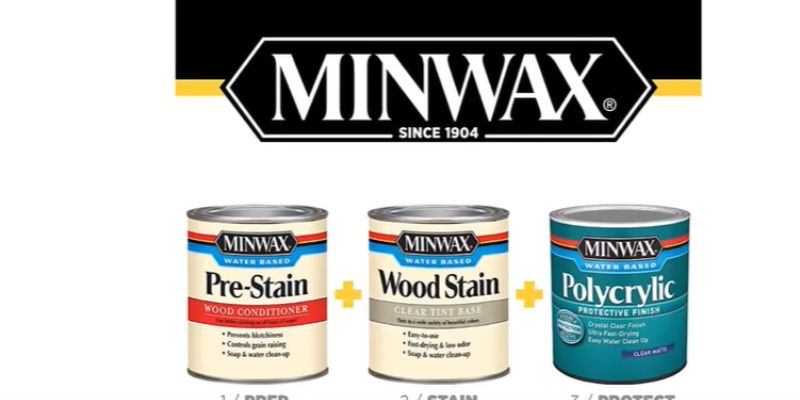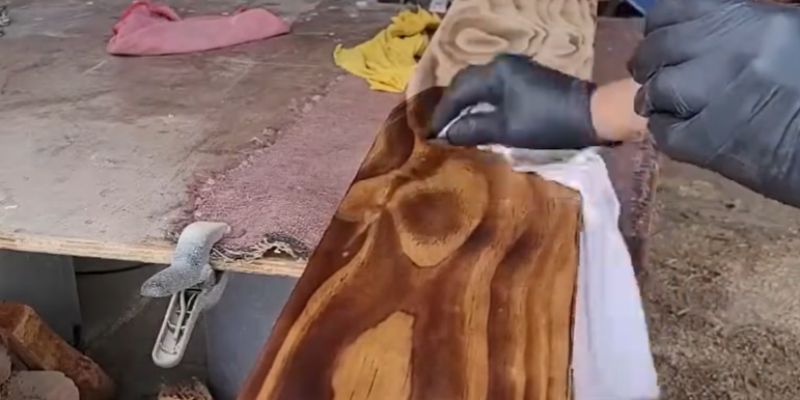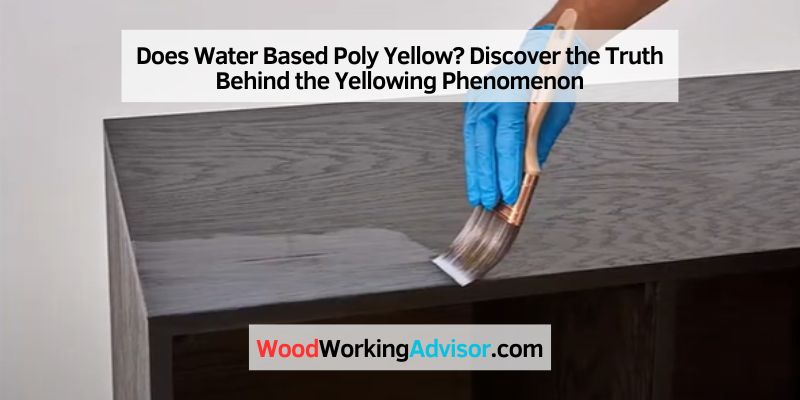No, water-based poly does not yellow. Water-based polyurethane is a clear finish that maintains its transparency and does not turn yellow over time.
Water-based polyurethane is a popular choice for finishing furniture, floors, and other wooden surfaces. It offers several advantages over oil-based polyurethane, including quicker drying times, low odor, and easy cleanup with soap and water. One common concern when using water-based polyurethane is the possibility of yellowing over time.
However, this is not an issue with water-based polyurethane. Unlike oil-based polyurethane, which can develop a yellow or amber tint as it ages, water-based polyurethane remains clear and transparent. It is a durable and long-lasting finish that helps preserve the natural color of the wood without altering its appearance.
Understanding Water Based Polyurethane
Water-based polyurethane is a popular choice for finishing wood surfaces due to its low odor, quick drying time, and environmentally friendly properties. However, there is one question that often arises among woodworkers and homeowners alike: Does water-based polyurethane yellow over time?
What Is Water-Based Polyurethane?
Water-based polyurethane, as the name suggests, is a type of protective coating that contains water as a solvent instead of traditional solvent chemicals. It is commonly used to seal and protect wooden furniture, floors, and other surfaces. This type of polyurethane forms a clear, transparent layer that enhances the natural beauty of the wood while providing a durable and protective finish.
How Does Water-Based Polyurethane Differ From Oil-Based Poly?
Water-based polyurethane differs from its oil-based counterpart in several ways:
- Application: Unlike oil-based polyurethane, water-based polyurethane has a milky white appearance when wet, making it easier to see where it has been applied.
- Drying Time: Water-based polyurethane dries much faster than oil-based polyurethane, typically within a few hours. This allows for quicker project completion and less waiting time between coats.
- Odor: Water-based polyurethane has a much milder and less pungent odor compared to oil-based polyurethane, making it more pleasant to work with and less disruptive to indoor air quality.
- Yellowing: One of the key differences between water-based and oil-based polyurethane is their tendency to yellow over time. Unlike oil-based polyurethane, water-based polyurethane does not yellow significantly, preserving the natural color of the wood.
- Clean Up: Cleaning brushes and tools used with water-based polyurethane is easy, as they can be rinsed with water. Oil-based polyurethane requires the use of solvents for cleanup.
So, if you’re concerned about keeping your wood surfaces looking their best and maintaining their natural color, water-based polyurethane is the way to go. It provides a clear and durable finish without the risk of yellowing over time. Now that you understand the differences, you can confidently choose the right polyurethane for your next project.

The Yellowing Phenomenon
Water-based polyurethane offers many benefits over oil-based polyurethane, including a clear finish, low odor, and fast drying time. However, there is one potential drawback that can occur with water-based poly: yellowing. Yellowing refers to the process by which the clear finish of the polyurethane takes on a yellow hue over time. Understanding the causes of this yellowing phenomenon is essential for making informed decisions about your finishing projects.
Causes Of Yellowing In Water Based Polyurethane
Several factors contribute to the yellowing of water-based polyurethane. By understanding these causes, you can take proactive measures to minimize or prevent yellowing altogether.
1. UV Exposure:
Ultraviolet (UV) light from the sun is a primary cause of yellowing in water-based polyurethane. When exposed to sunlight, the polyurethane undergoes a chemical reaction that leads to the yellowing effect. Therefore, items or surfaces that are regularly exposed to direct sunlight are more likely to experience yellowing.
2. Heat:
Heat can accelerate the yellowing process in water-based polyurethane. High temperatures, such as those found in direct sunlight or near heat sources, can cause the polyurethane to darken and take on a yellowish tint more quickly. It is important to keep this in mind when applying water-based polyurethane to surfaces that may be subjected to heat regularly.
3. Moisture:
Excessive moisture can also contribute to yellowing in water-based polyurethane. When water-based polyurethane is exposed to high levels of humidity, the moisture can react with the polyurethane and lead to discoloration. This is particularly true in environments with poor ventilation or where condensation may occur.
Environmental Factors Impacting Yellowing
Along with the causes mentioned above, certain environmental factors can further impact the yellowing of water-based polyurethane. These include:
1. Air Quality:
Poor air quality can contribute to the yellowing effect. Dust particles and pollutants in the air can settle on the polyurethane surface and create a yellowish tint over time. Maintaining a clean environment and proper ventilation can help reduce this risk.
2. Chemical Exposure:
Exposure to certain chemicals can cause yellowing in water-based polyurethane. For example, cleaning products that contain bleach or ammonia can react with polyurethane and lead to discoloration. It is crucial to avoid using harsh chemicals or abrasive cleaners on surfaces finished with water-based polyurethane.
3. Aging:
Over time, water-based polyurethane naturally undergoes changes that may contribute to yellowing. The aging process, coupled with environmental factors and exposure to light, can gradually alter the appearance of the finish. Regular maintenance and refinishing can help mitigate the effects of aging.
Preventing Yellowing
Choosing The Right Formulation
When selecting a water-based polyurethane, opt for a product with UV stabilizers to help prevent yellowing. Look for formulations labeled as “non-yellowing” or “crystal clear” to ensure your floors or furniture maintain their natural appearance over time.
Best Practices For Application And Maintenance
Take precautions during application to minimize yellowing. Keep the area well-ventilated to aid in proper drying, as trapped moisture can contribute to premature yellowing. Additionally, always follow the manufacturer’s recommended drying times and avoid exposing the surface to direct sunlight during application and curing.
Regular maintenance is essential for preventing yellowing. Use cleaning products designed specifically for polyurethane and avoid using ammonia-based cleaners, as they can lead to discoloration. Regularly inspect and clean the surface to prevent the buildup of contaminants that can contribute to yellowing over time. Keep in mind that proper care and maintenance can significantly extend the lifespan of your water-based polyurethane finish.
In summary, preventing yellowing in water-based polyurethane applications requires careful consideration of the formulation, application techniques, and ongoing maintenance. By choosing the right formulation and implementing best practices for application and maintenance, you can keep your surfaces looking clean and pristine for years to come.
Dispel Myths And Misconceptions
Water-based polyurethane is a popular choice for protecting and enhancing the natural beauty of wood. However, there are some common misconceptions about whether water-based polyurethane is yellow over time. Let’s separate fact from fiction and shed some light on this topic.
Common Misbeliefs About Water-Based Polyurethane Yellowing
There are a few misconceptions floating around about water-based polyurethane and its tendency to yellow:
- Water-based polyurethane always yellows over time.
- All water-based polyurethane products are yellow equally.
- Water-based polyurethane doesn’t provide the same level of protection as oil-based counterparts.
Separating Fact From Fiction
Myth #1: Water-based polyurethane always yellows over time.
Contrary to popular belief, not all water-based polyurethane products are yellow over time. Yellowing can occur due to a variety of factors, such as exposure to UV light or certain chemicals. However, many high-quality water-based polyurethane products on the market today are specifically formulated to resist yellowing, providing long-lasting clarity to your wood surfaces.
Myth #2: All water-based polyurethane products are yellow equally.
Not all water-based polyurethane products are created equal when it comes to yellowing. The extent of yellowing can vary depending on the specific formulation of the product and the conditions it is exposed to. High-quality water-based polyurethane brands invest in research and development to minimize yellowing and provide products that maintain clarity over time.
Myth #3: Water-based polyurethane doesn’t provide the same level of protection as oil-based counterparts.
Water-based polyurethane may not have been the go-to choice for wood protection in the past, but advancements in technology have bridged the gap. High-quality water-based polyurethane products now offer excellent protection against moisture, chemicals, and daily wear and tear. Moreover, they often dry faster, have lower odor levels, and are easier to clean up than traditional oil-based polyurethane.
In conclusion, it’s important to dispel these myths and misconceptions surrounding water-based polyurethane yellowing. By choosing a reputable brand and following proper application guidelines, you can enjoy the benefits of water-based polyurethane without worrying about significant yellowing over time.
Conclusion And Recommendations
Water-based polyurethane can turn yellow over time due to its reaction with certain chemicals or exposure to sunlight. To prevent yellowing, it’s recommended to use a water-based polyurethane with UV protection and avoid applying it over oil-based stains. Additionally, storing the polyurethane in a cool, dark place can help maintain its clarity.
Final Thoughts On Water-Based Polyurethane Yellowing
After considering the various factors that contribute to water-based polyurethane yellowing, it can be concluded that this issue is quite common and can occur for a number of reasons. While water-based polyurethane generally offers better color retention than oil-based alternatives, it is still not entirely immune to yellowing. Factors such as exposure to sunlight, humidity, and chemical reactions can all contribute to the yellowing of water-based polyurethane.
Water-based polyurethane contains certain chemicals that react to UV rays, causing the yellowing effect over time. Additionally, high levels of humidity can impact the polymerization process and result in a yellowed appearance. It is important to note that some water-based polyurethane products are more prone to yellowing than others, so it is essential to choose a high-quality product.
Recommendations For Long-lasting Finish
For those seeking a long-lasting finish that resists yellowing, here are some recommendations:
- Choose a high-quality water-based polyurethane: Opt for a reliable brand that offers excellent reviews and a reputation for their products. Doing thorough research and reading customer feedback can help you find a polyurethane that is less likely to yellow over time.
- Protect from exposure to sunlight: Since UV rays are known to contribute to yellowing, it is crucial to protect your polyurethane-coated surface from direct sunlight. This can be achieved by using curtains, blinds, or UV-protective films on windows.
- Control humidity levels: Excessive moisture can impact the polymerization process and result in yellowing. Use dehumidifiers, proper ventilation, or air conditioning systems to maintain optimal humidity levels in your space.
- Follow manufacturer’s instructions: Always read and follow the instructions provided by the manufacturer for applying and maintaining water-based polyurethane. This ensures that you are using the product correctly and maximizing its potential to resist yellowing.
- Consider sanding and recoating periodically: Over time, wear and tear can degrade the protective layer of water-based polyurethane, making it more prone to yellowing. Regularly sanding and recoating the surface can help maintain its appearance and durability.

Frequently Asked Questions For Does Water Based Poly Yellow
Why Did My Water-Based Polyurethane Turn Yellow?
Water-based polyurethane may turn yellow due to multiple reasons such as exposure to sunlight, moisture, or certain chemicals. UV rays can cause oxidation, leading to a yellow tint. It’s essential to use polyurethane with UV inhibitors and avoid direct sunlight to prevent discoloration.
Which Polyurethane Does Not Yellow?
Some types of clear polyurethane do not yellow over time. These non-yellowing polyurethanes provide durable protection without changing the color of surfaces.
What Is The Downside Of Water-Based Polyurethane?
The downside of water-based polyurethane is its reduced durability compared to oil-based options. It may also require more frequent re-application. Water-based polyurethane can also raise the grain of the wood, requiring additional sanding.
Does Water-Based Poly Change Color?
Water-based poly does not change color.
Conclusion
Water-based poly can indeed yellow over time due to various factors like exposure to light and natural aging. While this yellowing may be inevitable, using UV-resistant poly, avoiding excessive exposure to sunlight, and applying a protective top coat can help mitigate the effects.
Understanding these factors can help you make informed decisions about protecting and maintaining your wood surfaces.


